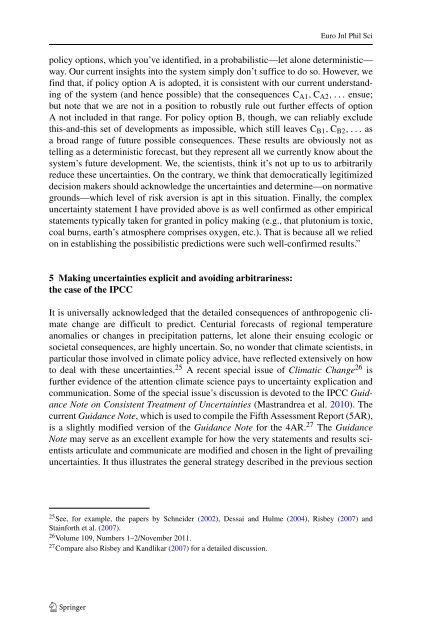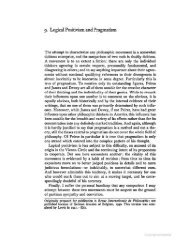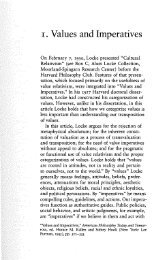In defence of the value free ideal
In defence of the value free ideal
In defence of the value free ideal
- No tags were found...
You also want an ePaper? Increase the reach of your titles
YUMPU automatically turns print PDFs into web optimized ePapers that Google loves.
EuroJnlPhilScipolicy options, which you’ve identified, in a probabilistic—let alone deterministic—way. Our current insights into <strong>the</strong> system simply don’t suffice to do so. However, wefind that, if policy option A is adopted, it is consistent with our current understanding<strong>of</strong> <strong>the</strong> system (and hence possible) that <strong>the</strong> consequences C A1 , C A2 ,... ensue;but note that we are not in a position to robustly rule out fur<strong>the</strong>r effects <strong>of</strong> optionA not included in that range. For policy option B, though, we can reliably excludethis-and-this set <strong>of</strong> developments as impossible, which still leaves C B1 , C B2 ,... asa broad range <strong>of</strong> future possible consequences. These results are obviously not astelling as a deterministic forecast, but <strong>the</strong>y represent all we currently know about <strong>the</strong>system’s future development. We, <strong>the</strong> scientists, think it’s not up to us to arbitrarilyreduce <strong>the</strong>se uncertainties. On <strong>the</strong> contrary, we think that democratically legitimizeddecision makers should acknowledge <strong>the</strong> uncertainties and determine—on normativegrounds—which level <strong>of</strong> risk aversion is apt in this situation. Finally, <strong>the</strong> complexuncertainty statement I have provided above is as well confirmed as o<strong>the</strong>r empiricalstatements typically taken for granted in policy making (e.g., that plutonium is toxic,coal burns, earth’s atmosphere comprises oxygen, etc.). That is because all we reliedon in establishing <strong>the</strong> possibilistic predictions were such well-confirmed results.”5 Making uncertainties explicit and avoiding arbitrariness:<strong>the</strong>case<strong>of</strong><strong>the</strong>IPCCIt is universally acknowledged that <strong>the</strong> detailed consequences <strong>of</strong> anthropogenic climatechange are difficult to predict. Centurial forecasts <strong>of</strong> regional temperatureanomalies or changes in precipitation patterns, let alone <strong>the</strong>ir ensuing ecologic orsocietal consequences, are highly uncertain. So, no wonder that climate scientists, inparticular those involved in climate policy advice, have reflected extensively on howto deal with <strong>the</strong>se uncertainties. 25 A recent special issue <strong>of</strong> Climatic Change 26 isfur<strong>the</strong>r evidence <strong>of</strong> <strong>the</strong> attention climate science pays to uncertainty explication andcommunication. Some <strong>of</strong> <strong>the</strong> special issue’s discussion is devoted to <strong>the</strong> IPCC GuidanceNote on Consistent Treatment <strong>of</strong> Uncertainties (Mastrandrea et al. 2010). Thecurrent Guidance Note, which is used to compile <strong>the</strong> Fifth Assessment Report (5AR),is a slightly modified version <strong>of</strong> <strong>the</strong> Guidance Note for <strong>the</strong> 4AR. 27 The GuidanceNote may serve as an excellent example for how <strong>the</strong> very statements and results scientistsarticulate and communicate are modified and chosen in <strong>the</strong> light <strong>of</strong> prevailinguncertainties. It thus illustrates <strong>the</strong> general strategy described in <strong>the</strong> previous section25 See, for example, <strong>the</strong> papers by Schneider (2002), Dessai and Hulme (2004), Risbey (2007) andStainforth et al. (2007).26 Volume 109, Numbers 1–2/November 2011.27 Compare also Risbey and Kandlikar (2007) for a detailed discussion.






